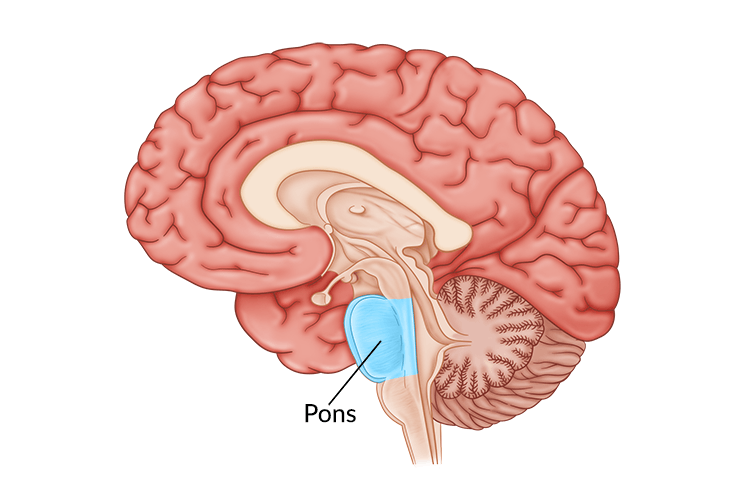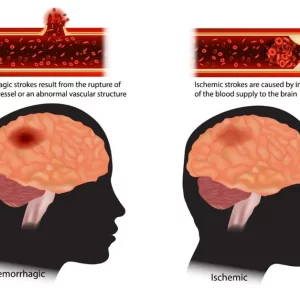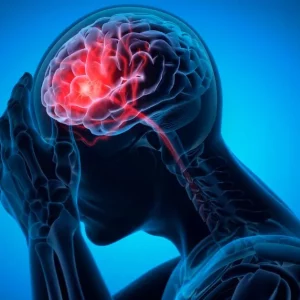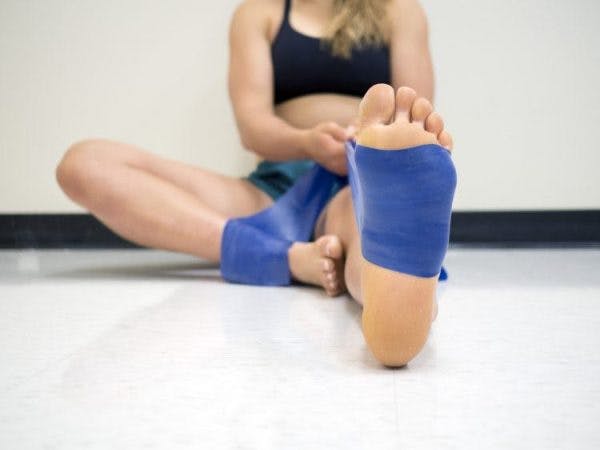The pons is the largest component of the brain stem. When blood flow to the pons becomes interrupted, it causes a pontine stroke or pons stroke. When the disruption is caused by a blood clot in particular, it’s referred to as a pontine infarction or pontine infarct.
As signals responsible for the body’s motor control flow through the pons, a common effect of a pontine stroke is hemiparesis, or weakness on one side of the body. In severe cases, a pontine stroke can result in a rare condition called locked-in syndrome where the entire body except for the eyes become paralyzed.
Fortunately, when a stroke only affects one side of the pons (unilateral pontine stroke), the prognosis is generally good and some survivors can even achieve a full recovery with timely treatment and rigorous rehabilitation. This article will even include a rare success story of a survivor with locked-in syndrome that partially recovered.
Use the links below to jump straight to any section about pontine stroke:
Causes of Pontine Stroke
A pontine stroke refers to a stroke within the pons, the largest component of the brain stem. Pontine strokes can be classified as either ischemic or hemorrhagic.
An ischemic stroke occurs when an artery in the brain becomes blocked by a blood clot, while a hemorrhagic stroke occurs when an artery in the brain bursts. Pontine strokes make up approximately 7% of all ischemic strokes (pontine infarct) and 10% of hemorrhagic strokes.
Hypertension and diabetes are two of the most common risk factors for all ischemic strokes and especially lacunar infarcts, a type of ischemic stroke that occurs in the deep areas of the brain such as the pons.
Other common causes of pontine stroke include diseases that affect the arteries such as small artery disease, large artery atherosclerosis (when the arteries become thickened with plaque), and cardiogenic emboli (when a blood clot travels from the heart to the brain).
Symptoms of Pontine Stroke
Brain stem strokes, including pontine strokes, have complex symptoms that often differ from the hallmark symptoms of a stroke. Typical symptoms of a stroke include slurred speech, facial drooping, and weakness on one side of the body.
However, when a stroke affects the pons, it can result in other symptoms, such as vertigo, dizziness, and severe imbalance. Some but not all pontine strokes also cause double vision, slurred speech, and decreased consciousness.
All strokes are medical emergencies that requires swift, immediate attention to restore blood flow in the brain and minimize brain damage and disability.
Secondary Effects of Pontine Stroke
Once a stroke has been treated and blood flow restored, doctors can assess the survivor for secondary effects. The effects of a pontine stroke vary from person to person depending on the size and location of the stroke. Since motor control signals flow through the pons, impaired motor control is a common outcome of a pontine stroke.
Here are some more of the most common secondary effects of a pontine stroke:
- Motor and/or sensory impairment: Each hemisphere of the brain controls movement and sensation on the opposite side of the body. When a stroke affects one side of the pons, it can result in motor and/or sensory impairment on the opposite side of the body (contralateral).
- Pure motor hemiparesis: Refers to weakness in the face, arms, and legs of one side of the body (contralateral to the pontine stroke) with no other deficits. About 10% of all first-ever ischemic strokes that result in pure motor hemiparesis are pontine strokes.
- Ataxic hemiparesis: Refers to weakness and ataxia (clumsy voluntary movements) on the same side of the body as the pontine infarct (ipsilateral). Although ataxia is strongly associated with cerebellar strokes, the cerebellum and brain stem share blood supply and therefore impact each other.
- Cranial nerve palsy: Refers to partial weakness or complete paralysis of the areas served by the affected cranial nerve. Following a pontine stroke, cranial nerve palsy generally occurs on the same side of the body as the infarct. There are twelve cranial nerves, many of which control eye movement.
- Dysarthria: Involves difficulty speaking due to lack of control over the muscles used in speech. This is different from aphasia, which causes difficulty speaking due to cognitive challenges such as comprehension and word retrieval.
- Dysphagia: Involves difficulty swallowing from the inability to control the muscles responsible for swallowing.
- Dysarthria-clumsy hand syndrome: Refers to a combination of facial weakness, severe dysarthria, dysphagia, and mild hand weakness and incoordination. This condition is most frequent after an internal capsule stroke or pontine stroke.
- Locked-in syndrome: Involves paralysis of all four limbs (tetraplegia) as well as the face. The eyes are still able move. The survivor retains full cognitive function, aware of their environment but unable to interact with it except with eye movement — as long as the other areas of the pons that control eye movement were unaffected.
- Pure sensory deficits: Some lacunar strokes such as a pontine stroke do not affect movement and instead only cause changes in sensation such as altered perception of touch, pain, temperature, pressure, vision, hearing, and taste.
The brain stem is small in size — only one half inch in diameter. Therefore, a pontine stroke is technically small in nature, but as you can see, the effects can be severe.
For example, locked-in syndrome causes paralysis of the entire body except for the eyes. Stroke survivor Jean-Dominique Bauby wrote a memoir about his experience with locked-in syndrome through his ability to blink just his left eye to select each letter of the alphabet as it was recited to him over and over. His memoir, The Diving Bell and the Butterfly, is one of our top recommended stroke recovery books.
Prognosis for a Stroke in the Pons
To understand your stroke recovery prognosis, it’s essential to talk to your doctor and neurologist. The location of your stroke has a strong impact on the prognosis and recovery outlook.
For example, the prognosis for a unilateral pontine stroke (when only one side of the pons is affected) tends to be good. Similarly, when the lateral to mid pons is affected, the outcome tends to be more favorable.
On the other hand, bilateral and caudal (lower) pontine infarctions tend to have a worse prognosis. When both sides of the pons are affected, it increases the chance of affecting movement on both sides of the body, such as with locked-in syndrome.
As with any stroke recovery prognosis, this information can serve as a guideline of what to expect, but individual recovery experiences may vary. Every stroke is different, and every recovery will be different. Some pontine stroke survivors that sustain severe impairments may require assistance long-term while others with the same effects may be able to recover substantial independence.
Ultimately, your prognosis is just one factor in a pool of many factors that influence recovery. The intensity of rehabilitation has an equally important impact on recovery outcomes.
Take Becky’s story for example:
After her brain stem stroke, she was paralyzed from the nose down (locked-in syndrome) and doctors told her that she would remain that way forever. Six weeks later, she woke up with complete use of her right side and partial movement on her left side. She made enormous gains in recovery and is still pursuing rehabilitation over a decade later.
Not every survivor with locked-in syndrome will experience spontaneous recovery like Becky. In fact, it’s very rare. However, Becky is living proof that every stroke is different and not every prognosis is true. Rehabilitation can always be pursued to maximize chances of recovery.
Rehabilitation for Pontine Stroke Survivors
Rehabilitation can take many forms to address the unique secondary effects caused by a pontine stroke. Your therapists will help you create a custom rehabilitation plan that addresses your unique goals to improve movement and/or sensation.
One major goal of rehabilitation is to spark neuroplasticity to help rewire the brain and recover as much function as possible. Neuroplasticity is activated through massed practice as the brain gets better at the activities and skills that we repeatedly practice.
Here are some of types of therapy that are commonly used to treat the effects of a pontine stroke:
Physical Therapy
During physical therapy, your therapist will guide you through rehabilitation exercises that help improve mobility in the affected muscles. Survivors with severe motor impairments can start slow with passive range-of-motion exercises to help prevent complications such as contractures or pressure sores. Passive movement also helps spark neuroplasticity and rewire the brain. Over time, they may be able to progress to more active exercises and even strengthening.
Want 25 pages of stroke recovery exercises in a PDF? Click here to download our free Stroke Rehab Exercise ebook now (link opens a pop up for uninterrupted reading)
Occupational Therapy
Your occupational therapist specializes in maximizing independence with the activities of daily living. Your OT will provide you with both functional exercises and any necessary compensation techniques to help you complete your daily tasks. They can also offer recommendations for home modifications to help prevent falls, discuss safety concerns and precautions following sensation loss, and provide resources for getting back to work or back to driving again.
Speech Therapy
Speech therapists are able to address difficulties with speaking, swallowing, and general communication skills. They may use a variety of exercises to improve the strength and coordination of the muscles surrounding your mouth and face. They can also suggest methods of communication other than speaking, called augmentative and alternative communication (AAC). For example, if you have locked-in syndrome, they may recommend using technology designed to track your eye movements to communicate.
Home Therapy
A strong home exercise program after stroke can make a noticeable difference during recovery. Whether you have mild, moderate, or severe effects that you wish to recover, your therapist can provide suitable exercises for you to practice at home. Home therapy is essential to keep the brain constantly stimulated and maximize neuroplasticity.
Sensory Retraining
Sometimes a pontine stroke can cause changes in sensation such as numbness, tingling, or difficulty sensing temperature. For these sensory issues, sensory retraining exercises might be able to help. It involves safely exposing your skin to various textures and temperatures to stimulate the brain.
Recovery from Pontine Infarct
Overall, a pontine stroke can affect movement and/or sensation on one or both sides of the body. Although pontine infarcts are technically small in nature, they can create significant effects such as locked-in syndrome, especially when both sides of the pons were affected.
Fortunately, with a rigorous rehabilitation regimen, survivors can stimulate the brain and maximize their chances of recovery. Not all survivors will achieve a full recovery, but it’s a possibility for many. Approach your stroke recovery prognosis with curiosity to see how far you can go.










